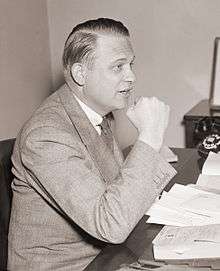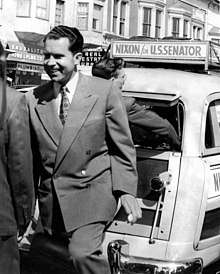Robert E. Stripling
Robert E. Stripling (circa 1910-1991) was a 20th-century civil servant, best known as chief investigator of the House Dies Committee and its successor the House Un-American Activities Committee (HUAC), particularly for collaboration with junior congressman Richard Nixon and for testimony gleaned from witness Elizabeth Bentley and Whittaker Chambers, the latter of whose allegations led indirectly to indictment and conviction of State Department official Alger Hiss in January 1950.[1][2]
Background

Robert E. Stripling Jr., was born around 1910 in San Augustine, Texas. He attended the University of Texas.[1][2]
Career

In 1932, before Stripling had finished college, U.S. Representative Martin Dies Jr., a Democrat from the Texas's 2nd congressional district, brought him to Washington, DC. Stripling had received what he himself called a "patronage job" in the "folding room" of the Old House Office Building at $120 per month while he attended night school.[1]
When the Dies Committee ran out of funding, Stripling helped persuade Dies to continue by offering to serve as secretary without wages. For the next decade, the committee recovered and grew to a staff of 75 and more than one million names, records, and data related to subversion, among which Stripling named the Pumpkin Papers of Whittaker Chambers.[1]
The cover of the original print run of Stripling's memoir The Red Plot Against America cites his title as "Chief Investigator, House Un-American Activities Committee, 1938–1948."[1] However, some sources call him "permanent counsel"[3] and "chief of staff."[4]
Famous HUAC investigations in which Stripling participated include: testimony of Soviet spy Gerhart Eisler, the Hollywood Trials (which derived from Eisler through his brother Hanns Eisler, a Hollywood music composter at the time, and their friend Bertolt Brecht[5]), testimony by writer Ring Lardner Jr.,[6] testimony by Elizabeth Bentley, and testimony by Whittaker Chambers and members of his Ware Group – Alger Hiss, Donald Hiss, Harry Dexter White, Lee Pressman, John Abt, Nathan Witt, Charles Kramer and others.[1]
On December 7, 1948, Stripling testified before HUAC in the Hiss Case.[7]
Personal and death
In 1971, Stripling married Louisa Fowler Shankland (previously married to Robert J. Zonne in 1948).[2]
Stripling died in 1991.[2]
Legacy
Stripling's collaboration with first-term U.S. Representative Nixon and their success in 1948 that lead to the Hiss Case (1949) proved the stepping stone to Nixon's rise to U.S. Senator (1950), U.S. Vice President (1952), and later U.S. President (1968).
Stripling appears in film in at least two documentaries regarding HUAC investigations.[8]
Works
One of the few mentions (much less reviews) of Stripling's book lumps it with several others about the House Un-American Activities Committee and states "They weren’t good books."[9]
- The Red Plot Against America, edited by Bob Considine (Drexel Hill, PA: Bell Publishing: 1949)[1]
See also
References
- Stripling, Robert E. (1949). The Red Plot Against America. Drexel Hill, Pennsylvania: Bell Publishing Company. pp. 22 (bio), 22–23 (HUAC). Retrieved 25 October 2017.
- "Louisa S. Stripling". Midland Reporter-Telegram. 7 June 2005. Retrieved 25 October 2017.
- Gellhorn, Martha (1988). The View from the Ground. Atlantic Monthly Press. p. 89. ISBN 9780871132123. Retrieved 25 October 2017.
- Weinstein, Allen (1978). Perjury: The Hiss-Chambers Case. New York: Knopf. ISBN 9780817912260. Retrieved 27 October 2017.
- Harrison, Patrick (14 February 2011). "The History of Dialogue (3): Brecht vs. the HUAC". New York Times. Retrieved 25 November 2017.
- Lardner Jr., Ring (2000). "I'd Hate Myself in the Morning". New York Times. Retrieved 25 November 2017.
- Hearings Regarding Communist Espionage in the United States Government – Part Two (PDF). US GPO. December 1948. pp. 1380-1381 (Robert E. Stripling), 1381-1385 (William Wheeler), 1385-1386 (Keith B. Lewis), 1386-1391 (Sumner Welles), 1391-1399 (John Peurifoy), 1399-1429 (Isaac Don Levine), 1429-1449 (Julian Wadleigh), 1449-1451 (Courtney E. Owens), 1451-1467 (Nathan L. Levine), 1467-1474 (Marion Bachrach). Retrieved 30 October 2018.
- "Robert E. Stripling". British Film Institute. Retrieved 25 October 2017.
- Goodman, Walter (13 March 1969). "HUAC Bibliography". New York Review of Books. Retrieved 25 November 2017.
External links
- Library of Congress: Photo - J. Parnell Thomas, chairman of House Un-American Activities Committee, (right) and Robert E. Stripling, committee investigator (1947)
- Getty Images: Photos of Robert E. Stripling
- Getty Images: Photo of Stripling with Richard Nixon in December 1948
- Visit the Capitol: Photo of Richard Nixon (right) and staff investigator Robert Stripling pose for photographs with the “Pumpkin Papers” (December 1948)
- New York: Photo of Stripling with Alger Hiss on August 5, 1948
- Nixon Foundation: Congressman Richard Nixon (right) and Congressional Investigator Robert Stripling examine microfilm (December 1948)